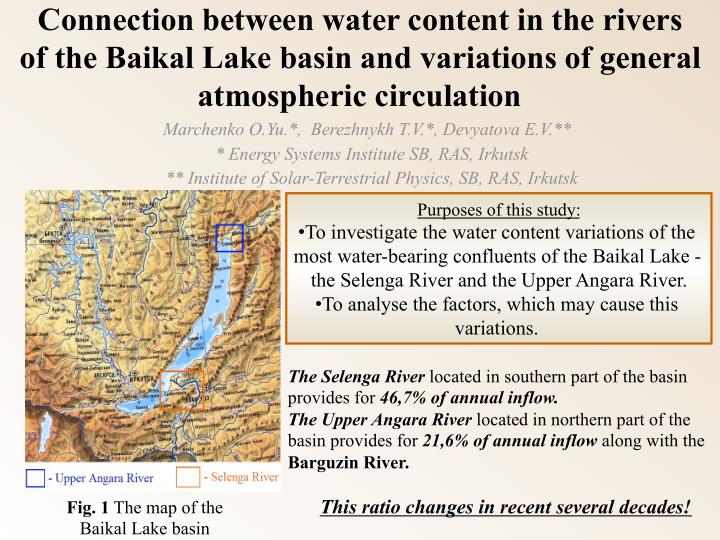



Connection between water content in the rivers of the Baikal Lake basin and variations of general atmospheric circulation Marchenko O.Yu.*, Berezhnykh T.V.*, Devyatova E.V.** * Energy Systems Institute SB, RAS, Irkutsk ** Institute of Solar-Terrestrial Physics, SB, RAS, Irkutsk Purposes of this study: • To investigate the water content variations of the most water-bearing confluents of the Baikal Lake - the Selenga River and the Upper Angara River. • To analyse the factors, which may cause this variations. The Selenga River located in southern part of the basin provides for 46,7% of annual inflow. The Upper Angara River located in northern part of the basin provides for 21,6% of annual inflow along with the Barguzin River. This ratio changes in recent several decades! Fig. 1 The map of the Baikal Lake basin
As pictured in Fig. 2 the Selenga River annual inflow is decreased from 1996 whereas the Upper Angara annual inflow is increased from 2000. Along with these trends growth of amplitude of the Selenga’s water content interannual variations is observed. The variations of atmospheric circulations may be the reason of observed changes in river water content. Fig. 2. Long-time variations of average annual river inflow. Information about intra-annual runoff distribution may help us to determine the water supply and factors influencing on water content for each of rivers. The histograms in Fig. 3 show that water supply for the Upper Angara River is total snow reserve and for the Selenga River – summer precipitation. The reason of observed runoff changes may be variability of summer and winter precipitations. Fig. 3. Intra-annual runoff variations of the Selenga River and the Upper Angara River.
Fig. 4 Long-time variations of time-averaged Summer ( Fig. 4 ). The Selenga River basin. precipitation, temperature and moisture. Precipitation decrease, temperature increase and Averaging period June – September. therefore lowering of moisture is observed during last several decades. Most likely these changes cause the low-flow period on the Selenga River. Winter The Upper Angara River basin. Model simulations and indirect evidences ( Мохов и др ., Мордвинов и др ., Абасов и др .) show increase of winter precipitations during last several decades, that may be the reason of the Upper Angara River annual inflow increase in this period. Conclusions • The territorial difference in the water content variations of the Baikal Lake main confluents has revealed. Water content is increased in the Upper Angara River (main water supply - winter total snow reserve) and decreased in the Selenga River (main water supply - summer precipitation) during last several decades. • Low-flow period on the Selenga River in summer is caused by precipitation decreasing and temperature increasing during last several decades. Whereas High-flow period on the Upper Angara River in winter is caused by winter precipitations increasing during this period. • The long-time changes of the circulation patterns also confirm obtained results. During last several decades over Siberia the frequency of anticyclonic weather is increased in summer and decreased in winter. • Out-of-phase water content variations of the Baikal Lake main confluents reduce a risk of extremely low water content values.
Модельные и косвенные оценки изменения количества атмосферных осадков : q Исследование изменения трендов осадков ( в % к общеклиматическому режиму 1961-1990) в XXI столетии ( Институт физики атмосферы им . Обухова РАН ). Мохов И . И . Оценка возможных региональных изменений гидрологического режима в XXI веке на основе глобальных климатических моделей / И . И . Мохов , В . А . Семенов , В . Ч . Хон // Известия РАН . Физика атмосферы и океана . – 2003. – Т .39. – № 2. – С .150-165. q Исследование изменений сезонных трендов приземного давления ( ИСЗФ СО РАН , ИСЭМ СО РАН ). Мордвинов В . И . Долговременные изменения общей циркуляции атмосферы Северного полушария в зимний и летний периоды / В . И . Мордвинов , И . В . Латышева , А . А . Караханян // Оптика атмосферы и океана . – 2003. Т .16. – № 1. – С . 66-73. Абасов Н . В . Гидрологические последствия изменений климата / Н . В Абасов , Т . В . Бережных , В . В . Ветрова // Тезисы межд . конф .– Новосибирск . 2007. C.6-7. q Расчеты изменения сезонного количества осадков , выполненные в Немецком центре вычислений климата и Институте метеорологии им . Макса Планка ( с КМОЦ ECHAM4/OPYC3). Welt im Wandel: Wege zu einem nachhaltigen Umgang mit Süßwasser / Wissenschaftlichen Beirat der Bundesregierung Globale Umweltveränderungen. – Berlin; Heidelberg; New York; Barcelona; Budapest; Honkong; London; Mailand; Paris; Santa Klara; Singapur; Tokio : Springer, 1998. – 420 c.
Карты изменения климатических показателей между периодами 1948-1977 и 1978-2006 гг . Давление Температура
Recommend
More recommend